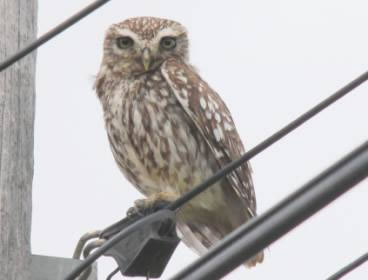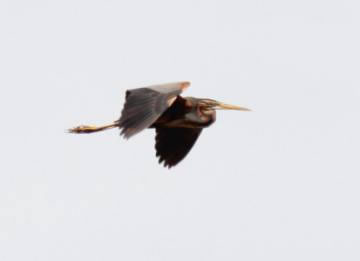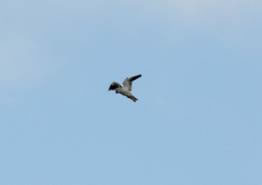Visit your favourite destinations |
| A Report from birdtours.co.uk |
Western Algarve, 28th April to 5th May 2012.,
References:
A Birdwatching Guide to the Algarve – Carlson
Summer Birding on the Central Algarve – Jon Hardacre
Michelin Map 593 Portugal Sud Algarve
INTRODUCTION
Essentially a family holiday with my wife, but as is often the case, a considerable amount of time spent birding. Having said that, no early morning or evening birding was carried out, so all the sightings relate to the main part of each day.
The holiday was centred around the small resort of Alvor, staying at the Pestana Alvor Praia. The hotel is situated at the Eastern end of Alvor bay, in well laid-out gardens, which held Sardinian Warbler, Serin, Azure-winged Magpie and Blackcap. Looking from the balcony, Yellow-legged Gulls were plentiful, a pair of kestrels lived close by and, Whimbrels and Cattle Egrets passed daily. The sea was generally quiet but distant Gannets were usually present, flying West.
The Western end of Alvor beach is where two rivers, the Ria Alvor and Ria Odiaxere meet the sea. This large estuary area borders Alvor Marsh (see later). The dunes behind the beach have a boardwalk where many Crested Lark were seen and good views of the Alvor estuary can be had. There is a pool along the boardwalk with three small islands, Bee-eaters are at nest-holes in the banks. A large gull roost occurs in the estuary mouth where Little, Sandwich and (last year) Caspian Tern were found.
Daily Sightings:
Directions are not given, as this report should follow others with accurate details to what are, well known sites. The reference books still hold good and their information is valuable. One site of personal preference is explained as it doesn’t feature in other reports.
29th April - my Birthday! – Alvor Marsh
Leaving the N125 after the Station (Estacao) sign, pass over the level crossing. This is the best area we found for Bee-eaters and (staying in the car), they perched very closely in bushes and on power lines.
The road down to the marsh was excellent for Little Owl, 2 Cuckoos were seen and a male Golden Oriole. The surrounding fields had many Cattle Egrets, 4 White Storks, Red-legged Partridge and 2 Hoopoes.

Little Owl – Roadside, Alvor Marsh.
From the car park, the saltpans can be accessed where Fan-tailed Warblers were plentiful. A family of Stonechats flitted about and a flock of juvenile Flamingos fed on the pans.
Waders included Greenshank, Whimbrel, Kentish Plover and two Oystercatcher, the latter being scarce here.
30th April
A return visit to the marsh where additional birds seen were – 3 Nightingale, 2 Cetti’s Warbler, Wren and several Quail calling.
1st May
A drive direct to Cape St. Vincent. Stunning scenery on the high sea cliffs – and not a safety barrier in sight!
3 Blue Rock Thrush were seen quite closely and very bright Stonechats were perching on several bushes. 2 Choughs were seen flying at a distance, made slightly more difficult by the presence of 3 Jackdaws also. 4 or 5 Black Redstarts were present on, or just over the cliff-tops. Many Gannets were on the sea also.
The site was not too busy with tourists and all the above were found within half an hour.
2nd May
Pera Marsh – well documented in the References, however I would recommend driving into Pera then, keeping an eye on the coast, cross a roundabout with a stone tower next to it and turn left shortly after.
This an excellent site (40 species in 2 hours),comprising a large expanse of water behind the dunes – revealing Flamingoes, 3 Spoonbill and a variety of common duck species and waders.
The surrounding fields and marshlands showed birds typical of such habitats. Crested and Short-toed Lark, Red-rumped Swallows, Little Owl, Bee-Eaters, Yellow Wagtail (iberiae) and Corn Bunting.
A closer look at the marsh gave us excellent views of 8 Purple Gallinule, 1 Reed Warbler, several Cetti’s and Fan-tailed Warblers. A sudden rush of Swallows, Swifts and House Martins also contained 3 Alpine Swifts.
We were about to leave when 3 Glossy Ibis, previously unseen, took flight and passed overhead.
We were about to leave again when a Purple Heron flew past the car and into the marsh. We stayed a little longer and a Peregrine flew through!

Purple Heron – Pera Marsh
3rd May
Today was the trek up to Castro Verde via the motorway.
The rolling plains to the East are described in Carlson, Hardacre as the most suitable sites for Bustards. They could be anywhere in that area and we found two distant Great Bustards, but from which minor road, I’m not sure. It’s just a matter of scanning and searching!
The weather this day was poor with almost constant, heavy rain. I knew that raptors would be in short supply. A brief let up at lunchtime saw a Booted Eagle, Marsh Harrier and two Montagu’s Harrier take to the air along with one Common Buzzard.
We settled for watching the Spanish Sparrows at home in the White Stork nests and two Southern Grey Shrikes in a nearby tree. Slightly despondent at not seeing more of the Alentejo birds, we made our way back to Castro Verde.
A couple of miles outside Castro Verde on the N123, I suddenly saw what I was sure to be a Roller flying parallel to the road. I stopped the car (quickly!) and refound the adult bird, perched on telephone wires. Again, poor light but a cracking adult bird and what a superb find. What a great way to end the day too!

Roller – Castro Verde
4th May
This was the first day the weather looked clear in the Monchique hills, so we took the picturesque drive up the valley (N266). We revisited a small village, Caldas da Monchique which is well worth noting, the birding is excellent. Turn left at a roundabout before Monchique, where a health spa hotel stands. Follow the road a short distance and park near the bottling factory!
The village lies in a deep gorge, where a stream supplies a thermal bath spa and the small factory. It doesn’t sound pretty but it really is! Walk the grounds of the spa, checking the bushes and the mixed trees which are either side of the gorge.
The first call heard was Nuthatch and several were seen, which were my first in the Algarve last year. They were followed by Crested Tit, Grey Wagtail around the stream and 2 Golden Orioles singing high in the eucalyptus trees. A new tick for the Algarve list was a Hawfinch, seen flying between two pines. Other birds seen here were Jay, Robin, White Wagtail, Green Woodpecker and a Western Bonelli’s Warbler. Surprisingly, no raptors were encountered in this hilly, wooded valley.
5th May Return to Faro airport.
Our flight was late in the evening, so the day was spent working our way slowly East to Faro.
The first call was another look at Pera Marsh. At the far end of the boardwalk, by the large reedbed, 2 Little Bitterns were seen flying in quick succession. 3 Waxbills passed quickly over the reeds.
At another part of the site, we met with other birders, including a couple who live not far away in our home town! The conversation revolved around a Black-shouldered Kite which had flown through the marsh earlier that morning. I winced, the bird I’ve looked for without success on nine previous holidays, and only a few hours left.
I searched the nearby fields and near the café, saw 2 Woodchats, a Magpie(black-billed) and a flying Stone Curlew. I returned to the others and heard of a further sighting at Vilamoura.
Lunch was needed (and shopping), so we went into the centre of Albufeira. Not our idea of the Algarve at all – a tacky, worn looking place and we were quickly on our way. Vilamoura was the next town – you can guess what’s coming next! I re-read Jon Hardacre’s notes on Falesia Lagoon at Vilamoura and his sightings of Black-shouldered Kite.
We arrived at a large reedy pool, having seen signs for a Lakeside Hotel (clue). Within ten minutes, I saw a small, silvery raptor flying towards me, passing fairly close and pausing to hover over a field. I watched it hunting, hovering, diving and finally perching in a distant tree to eat its prey. With the sun finally out, I took distant photos, but that didn’t matter – I’d found it, with two hours to spare!!!

Conclusion.
111 species in the week was an excellent total and I was pleased to have found them all unassisted. I have listed the more notable birds only, as I feel visiting birders appreciate knowing their whereabouts.
It struck me that, compared with the same week last year, there was a distinct lack of migrants – only 2 Woodchats in a week, many of the birds listed were single sightings only. Hirundines were in small numbers, particularly Swifts being absent in the towns.
The species list varies considerably with each season and I would thoroughly recommend the Algarve for interesting bird-watching and invariably, a surprise sighting.
Why not send us a report, or an update to one of your current reports?